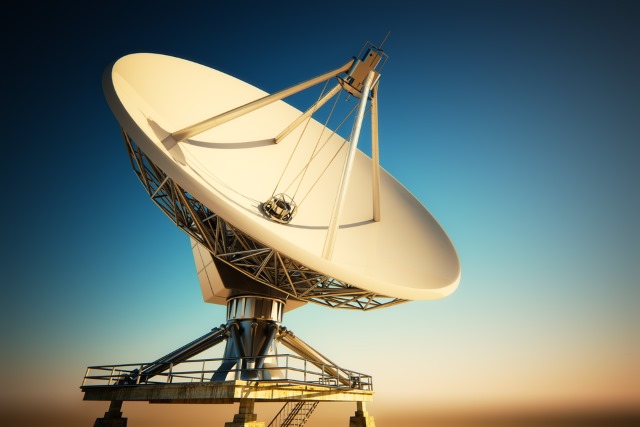Satellite internet is a connection technology that does not depend on cables and works through a satellite dish.
The main advantage of satellite internet is that it allows wireless connections with a wide range of coverage, making it possible to bring internet connectivity to remote areas and places not served by fiber optics and other terrestrial connection technologies.
Satellite internet began to gain popularity in 2015 when SpaceX announced plans to launch a network of satellites for high-speed, low-latency internet. Then In 2019, SpaceX initiated the launch of its Starlink satellites.
There was a big jump in satellite access with the arrival of Starlink, which uses low Earth orbit (LEO) satellites and offers high speeds, unlimited access and prices closer to conventional fixed broadband.
Next, understand how satellite internet works, its advantages, limitations, and the companies that offer this type of service.
What is satellite internet?
Satellite Internet is a type of connection that provides internet access without depending on terrestrial cable infrastructure, through a satellite dish that is positioned outdoors and communicates with a satellite.
This type of connection is commonly found in rural areas and difficult-to-access locations, such as islands and mountainous regions. Satellite internet allows isolated locations to achieve global connectivity and high data transfer rates depending on the service chosen.
How does satellite internet work?
Internet via satellite with satellite dishes, which communicate with satellites in geostationary orbit or low orbit (LEO).
The satellite dishes have transceivers that must be connected to the modem via satellite — this connection can be made via coaxial cable or Ethernet, depending on the equipment used.
In addition to the satellite dish located at the customer’s home, satellite internet providers also need to have ground stations (hub), with satellite dishes that receive the satellite signal and interconnect with internet data centres via fiber optics.

Communication between antennas and satellites takes place with different types of bands, such as C Band, Ka Band or Ku Band.
Satellite internet transmission technology is very different from satellite TV, as network connections need to send and receive signals, while TV services only require receiving a signal at the customer’s home.
What bands are used by satellite internet?
There are different bands in satellite internet such as Ka band, Ku band and C band. Low orbit satellite companies, such as Starlink, use different frequencies, around 18 GHz for download and 28 GHz for upload.
The differences between the bands include the cost of infrastructure, price of equipment, data transmission capacity and stability in adverse situations, such as rain and heavy clouds.
Is satellite internet broadband?
Most of the time, yes. Although there are satellite connections with low speeds, providers offer speeds above 10 Mb/s. However, satellite internet speeds are lower than fiber optic or coaxial cable provider services.
Is there free satellite internet?
Yes, it is possible to access free satellite internet from the Federal Government Programs. Some government programs provide subsidized internet access for low-income families or rural areas, which may include satellite internet options with reduced costs or even free access under certain conditions.
To see if such programs exist in your area, you should check with your local government or internet service providers (ISPs).
On the other hand, it is not possible to have free satellite broadband in your home or business.
Does satellite internet work on mobile phones?
It is possible to use satellite internet on a mobile phone via Wi-Fi. In this case, it is necessary to have satellite internet service with a wireless router installed.
Some network operators’ terrestrial antennas communicate via satellite instead of using fiber optic backhaul or microwave radio. In this case, the connection between the tower and the smartphone is made via 4G, without the need for a satellite chip for cell phones; then the data or calls are transmitted by the satellite dish.

There are mobile phones with satellite connectivity, including the iPhone 14 and above. However, this communication does not allow you to access the internet or make calls, only exchange short messages with emergency services.
The telecommunications industry is also working to make NTN technology available, which uses low-orbit satellites to deliver signals directly to smartphones using existing technologies such as 4G and 5G. There is still no forecast of when these networks will come into operation, but Starlink has already launched the first satellites with the Direct to Cell service and has signed partnerships with some foreign operators.
What are the advantages of satellite internet?
Satellite internet offers great advantages such as availability and speed. Below is a list of other benefits of this type of connection:
- Wide coverage: satellite internet can serve entire countries or even continents with a single satellite, allowing connectivity to areas where there is no cable or fiber optic presence.
- Mobility: as it covers a larger coverage area, it is possible to take the antenna and equipment to other locations and stay connected. Some services can be installed on boats, aircraft, trucks and motorhomes, maintaining the internet connection even when moving.
- Ease of installation: to install satellite internet it is not necessary to run cables to poles or to the street. In some cases, the installation can be done by the user, by simply fixing the antenna on the roof or other open area and connecting the cables according to the manufacturer’s instructions.
- Speed: satellite internet can reach speeds of over 200 Mb/s, achieving better results than 3G, 4G and some radio connections.
What are the disadvantages of satellite internet?
Satellite internet may have limitations in performance and cost. Some challenges and disadvantages of this type of connection are listed below:
- High latency: the ping of connections to geostationary satellites is high and compromises tasks such as online games and video calls. In low orbit connections, such as Starlink, the latency performance is similar to that of a terrestrial connection, but the delay is still greater than in fiber optic access.
- Antenna positioning: the satellite internet antenna must be positioned in the open sky and with a clear horizon, compromising installation in apartments or in areas with a higher density of buildings.
- Speed performance: fiber optic connections reach gigabit speeds, while satellite internet can reach 250 Mb/s on the Starlink plan.
- Data limitations: many satellite providers impose maximum monthly data limits like a cell phone plan, while fiber optic or cable broadband usually have no limits.
- Momentary unavailability: satellite internet may be unavailable in some situations, such as heavy clouds, rain, solar interference and electromagnetic interference.
Which companies offer satellite internet?
There are several companies that offer satellite broadband for individuals:
- Starlink: SpaceX’s Starlink is rapidly expanding and aims to offer worldwide coverage. It boasts potentially the fastest satellite internet speeds but can be more expensive and may have waitlists in some areas. Starlink as at the the time of writing this post is the only Satellite Internet Provider in Nigeria.
- Viasat: Viasat provides satellite internet globally, especially in underserved areas. They offer a range of plans with varying speeds and data allowances.
- EchoStar: EchoStar satellite power services like HughesNet and DishNet, offering options for different regions and needs.
- HughesNet: This is a popular choice in the US, particularly for rural areas. They offer affordable plans with data caps and varying speeds.
Is Satellite Internet available anywhere?
No. There are areas in the world that are not served by all satellite internet providers, especially in the oceans and some remote islands and polar regions.
Still, satellite internet has a much greater scope than any other communications technology, including mobile networks, fiber optics or radio waves. A single satellite is capable of covering entire countries or continents, but the service area is chosen by the operator during satellite development.
Is satellite internet better than fiber optic?
Satellite internet’s main positive point is wide coverage, but it has a high cost and lower performance than terrestrial connections. On the other hand, optical fiber can deliver very high speeds with low latency, but has limited availability and does not reach remote areas.
Is satellite internet better than radio?
Both types of wireless communication have advantages and disadvantages: satellite internet has greater coverage, and a single satellite can serve entire countries or continents; The radio connection has a restricted range and requires antennas with a direct view (without obstacles) between the client and the provider.
The radio connection can benefit from lower latency and greater bandwidth availability per customer, allowing for plans with unlimited data. Depending on the equipment used, internet radio delivers higher download and upload speeds.
Both technologies are subject to unavailability in the event of rain, but radio internet is more susceptible than satellite to radio frequency interference caused by equipment such as mobile phones, routers and mobile phone antennas.
Read Other Articles:
- Why Keyboard is not arranged in Alphabetical Order
- What do the specifications on cables and chargers mean for power (W), current (A), and voltage (V)?
- How to Differentiate Between a USB Charge-Only Cable and a USB Data Cable






